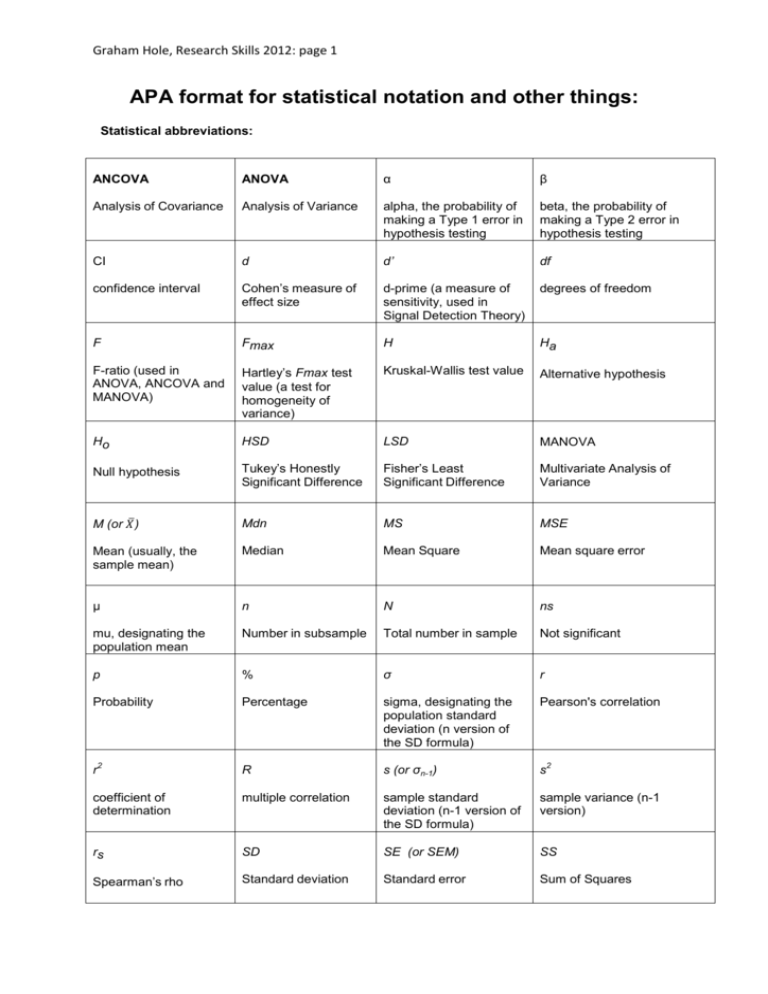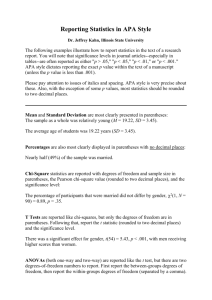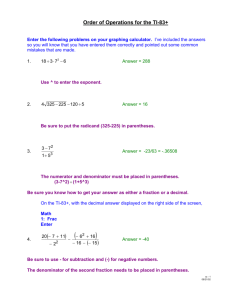APA Statistical Notation Guide | Research Skills
advertisement

Graham Hole, Research Skills 2012: page 1 APA format for statistical notation and other things: Statistical abbreviations: ANCOVA ANOVA α β Analysis of Covariance Analysis of Variance alpha, the probability of making a Type 1 error in hypothesis testing beta, the probability of making a Type 2 error in hypothesis testing CI d d’ df confidence interval Cohen’s measure of effect size d-prime (a measure of sensitivity, used in Signal Detection Theory) degrees of freedom F Fmax H Ha F-ratio (used in ANOVA, ANCOVA and MANOVA) Hartley’s Fmax test value (a test for homogeneity of variance) Kruskal-Wallis test value Alternative hypothesis Ho HSD LSD MANOVA Null hypothesis Tukey’s Honestly Significant Difference Fisher’s Least Significant Difference Multivariate Analysis of Variance M (or 𝑋�) Mdn MS MSE Mean (usually, the sample mean) Median Mean Square Mean square error µ n N ns mu, designating the population mean Number in subsample Total number in sample Not significant p % σ r Probability Percentage sigma, designating the population standard deviation (n version of the SD formula) Pearson's correlation R s (or σn-1) s coefficient of determination multiple correlation sample standard deviation (n-1 version of the SD formula) sample variance (n-1 version) rs SD SE (or SEM) SS Spearman’s rho Standard deviation Standard error Sum of Squares r 2 2 Graham Hole, Research Skills 2012: page 2 t T U x t-test value Wilcoxon test value Mann-Whitney test value Horizontal axis on a graph y z Σ 2 Χ Vertical axis on a graph z-score Sum Chi square test value Other commonly used abbreviations : °C cm °F g Degrees Centigrade h Centimetre(s) IQ Degrees Fahrenheit kg Gram(s) km Hour(s) kph Intelligence Quotient L Kilogram(s) m Kilometre(s) m² Kilometres per hour mg Litre(s) min Metre(s) ml Square metre(s) mm Milligramme(s) ms Minute(s) Millilitre(s) RT Millimetre(s) s Reaction Time Second(s) Millisecond(s) Jeffrey Kahn's guide to APA format is reproduced below. Find the original here: http://my.ilstu.edu/~jhkahn/apastats.html Reporting Statistics in APA Style Dr. Jeffrey Kahn, Illinois State University The following examples illustrate how to report statistics in the text of a research report. You will note that significance levels in journal articles--especially in tables--are often reported as either "p > .05," "p < .05," "p < .01," or "p < .001." APA style dictates reporting the exact p value within the text of a manuscript (unless the p value is less than .001). Please pay attention to issues of italics and spacing. APA style is very precise about these. Also, with the exception of some p values, most statistics should be rounded to two decimal places. Graham Hole, Research Skills 2012: page 3 Mean and Standard Deviation are most clearly presented in parentheses: The sample as a whole was relatively young (M = 19.22, SD = 3.45). The average age of students was 19.22 years (SD = 3.45). Percentages are also most clearly displayed in parentheses with no decimal places: Nearly half (49%) of the sample was married. Chi-Square statistics are reported with degrees of freedom and sample size in parentheses, the chi-square value (rounded to two decimal places), and the significance level: The percentage of participants that were married did not differ by gender, χ2(1, N = 90) = 0.89, p = .35. T Tests are reported like chi-squares, but only the degrees of freedom are in parentheses. Following that, report the t statistic (rounded to two decimal places) and the significance level. There was a significant effect for gender, t(54) = 5.43, p < .001, with men receiving higher scores than women. ANOVAs (both one-way and two-way) are reported like the t test, but there are two degreesof-freedom numbers to report. First report the between-groups degrees of freedom, then report the within-groups degrees of freedom (separated by a comma). After that report the F statistic (rounded off to two decimal places) and the significance level. There was a significant main effect for treatment, F(1, 145) = 5.43, p = .02, and a significant interaction, F(2, 145) = 3.24, p = .04. Correlations are reported with the degrees of freedom (which is N-2) in parentheses and the significance level: The two variables were strongly correlated, r(55) = .49, p < .01. Regression results are often best presented in a table. APA doesn't say much about how to report regression results in the text, but if you would like to report the regression in the text of your Results section, you should at least present the unstandardized or standardized slope (beta), whichever is more interpretable given the data, along with the t-test and the corresponding significance level. (Degrees of freedom for the t-test is N-k-1 where k equals the number of predictor variables.) It is also customary to report the percentage of variance explained along with the corresponding F test. Graham Hole, Research Skills 2012: page 4 Social support significantly predicted depression scores, β = -.34, t(225) = 6.53, p < .001. Social support also explained a significant proportion of variance in depression scores, R2 = .12, F(1, 225) = 42.64, p < .001. Tables are useful if you find that a paragraph has almost as many numbers as words. If you do use a table, do not also report the same information in the text. It's either one or the other. Based on: American Psychological Association. (2010). Publication manual of the American Psychological Association (6th ed.). Washington, DC: Author.


